| A good double-lap slated roof can be a good and
faithful servant, looking good and keeping out the elements over a long
period of time. A poorly constructed double-lap slated roof containing
broken slates can be an ongoing nightmare. Identifying the broken slates
can be part of the nightmare. |
| Access to the roof for inspection purposes must
be safe and within the health and safety risk guidelines laid down for all
roofing work. To do a proper inspection and repair, the roof will need to
be divided into sections and every slate checked from the ridge down to
the eaves, marking, removing and replacing defective slates as the
inspection proceeds. Returning to the same section of roof at a later date
to undertake the removal or replacement of the slates could result in
further breakage. |
| Some broken slates are easy to see as they have
either split down the length of the slate or have slid down the roof into
the gutters. Others however will be much more difficult to find as they
are not visible, having broken above the nail fixings. |
|
Hidden breaks |
| To find the broken slates a thin blade (1-2mm thick) should be slid
under the leading edge of the slate, and twisted to lift the slate. If the
slate is good it will not lift. If however it does lift with very little
effort, and does not slide down the roof, it is probably broken above the
nail holes. If it swings sideways it probably has a diagonal break
starting above one nail fixing and finishing below the other. If the slate
slides down the roof it has either broken below or between the nail fixing
holes, or has not been nailed at all. |
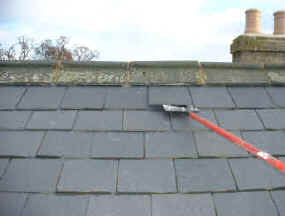 |
|
Using a thin blade to lift the leading edge of
a slate will not break a good slate unless extreme force is used |
|
Mastic |
| Whilst un-nailed slates on a roof may sound
unlikely, some roofers have been known to replace slates using mastic or
silicone sealant. The mastic/sealant may stick very well to the surface of
a slate, but unfortunately with natural slates the laminar structure of
the slate means that the mastic/sealant may only be adhered to the outer
surface flake. Resin slates should be better in this respect as they are
not laminar, however to prevent them from sticking in the mould during
manufacture, silicone release agents are used. Traces of the silicone
remain on the surface of the slates, which will discourage the mastic from
sticking to it. |
| Slates fixed with mastic may be easily identified by traces of the
material showing around the edges. Alternatively by using the thin blade
technique, the blade will be difficult to slide between the slates. Once
in position the slates will ping apart before any twist is applied. If the
adhesion between the mastic and the slate is impossible to break,
consideration for the long-term life of the mastic relative to the design
life of the roof should be considered. |
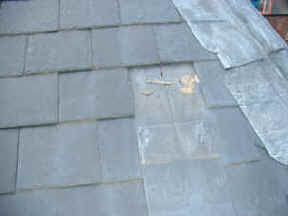 |
|
The adhesion life of the mastic needs to be
longer than the design life of the roof. |
|
Hairline Fractures |
| It is possible that a slate that has been walked on has been fractured
but has not failed. In this instance it may be possible to see the
fracture as a hairline, especially while a roof is drying out. Water in a
crack will take longer to evaporate than from the surface of a slate. The
long-term effect of ice expanding in the crack will eventually cause the
hairline to develop into a broken slate. Where this is not possible top
see the hairline fracture, they can be detected by sliding a thin blade
under the leading edge of the slate, and twisting it, the fracture will show
itself, or the stress created will break the slate. A fractured slate will
need very little effort to break it. |
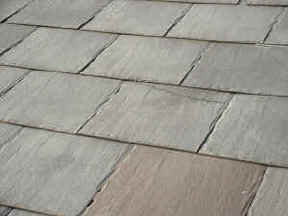 |
|
Type of fracture |
| It is possible to identify whether a broken slate was caused
by a natural fissure in the material or caused by an imposed load such as
hitting or walking on a slate. By looking at the shape of the fractured
edge a difference can be seen. If the fracture is straight it is likely to
be a natural fissure. If it has a combination of a convex curve and a
vertical edge, it is likely to be a stress fracture caused by an imposed
load. With resin slates a natural fracture is impossible, so all breakages
are likely to be stress fractures. |
|
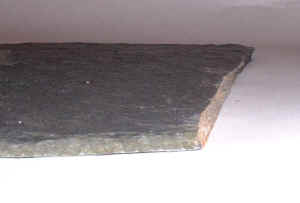 |
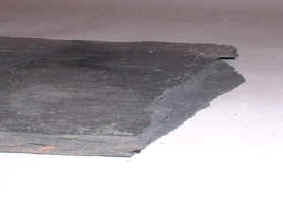 |
|
Conclusion |
| Having identified the broken, fractured or
glued slates, and the possible cause of the problem, all the defective
slates will need to be replaced to make the roof weather tight. By working
systematically backwards across and down each section of roof, it can be
returned to a safe long lasting condition. |